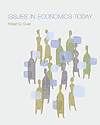| ceteris paribus | Latin for other things equal.
|
 |
 |
 |
| consumers | Those people in a market who want to exchange money for goods or services.
|
 |
 |
 |
| demand | The relationship between price and quantity demanded, ceteris paribus.
|
 |
 |
 |
| demand schedule | Presentation, in tabular form, of the price and quantity demanded for a good.
|
 |
 |
 |
| equilibrium | The point where the amount that consumers want to buy and the amount firms want to sell are the same. This occurs where the supply curve and the demand curve cross.
|
 |
 |
 |
| equilibrium price | The price at which no consumers wish they could have purchase more goods at the price; no producers wish they could have sold more.
|
 |
 |
 |
| equilibrium quantity | The amount of output exchanged at the equilibrium price.
|
 |
 |
 |
| excess demand | Another term for shortage.
|
 |
 |
 |
| excess supply | Another term for surplus.
|
 |
 |
 |
| fixed costs | Expenses that do not change whether you produce zero or any other amount.
|
 |
 |
 |
| law of demand | The statement that the relationship between price and quantity demanded is a negative or inverse one.
|
 |
 |
 |
| law of diminishing marginal utility | The amount of additional happiness that you get from an additional unit of consumption falls with each additional unit.
|
 |
 |
 |
| law of supply | The statement that there is positive relationship between price and quantity supplied.
|
 |
 |
 |
| loss | The money a firm makes is less than its costs (costs - revenue).
|
 |
 |
 |
| marginal cost | The increase in cost associated with increasing production by one unit.
|
 |
 |
 |
| marginal revenue | The increase in revenue associated with increasing sales by one unit.
|
 |
 |
 |
| marginal utility | The amount of extra happiness that people get from an additional unit of consumption.
|
 |
 |
 |
| market | Any mechanism by which buyers and sellers negotiate an exchange.
|
 |
 |
 |
| output | The good or service produced for sale.
|
 |
 |
 |
| price | The amount of money that must be paid for a unit of output.
|
 |
 |
 |
| producers | Those people in a market who want to exchange goods or services for money.
|
 |
 |
 |
| profit | The money a firm makes in excess of its costs (or revenue - cost).
|
 |
 |
 |
| quantity demanded | Amount consumers are willing and able to buy at a particular price during a particular period of time.
|
 |
 |
 |
| quantity supplied | Amount firms are willing and able to sell at a particular price during a particular period of time.
|
 |
 |
 |
| real-balances effect | When a price increases your buying power is decreased causing you to buy less
|
 |
 |
 |
| revenue | Money received from sales.
|
 |
 |
 |
| shortage | The condition where firms do not want to sell as many goods as consumers want to buy.
|
 |
 |
 |
| substitution effect | Purchase of less of a product than originally wanted when its price is high because a lower-cost product is available.
|
 |
 |
 |
| sunk costs | Expenses that do not change whether you produce zero or any other amount.
|
 |
 |
 |
| supply | The relationship between price and quantity supplied, ceteris paribus.
|
 |
 |
 |
| supply and demand | The name of the most important model in all of economics.
|
 |
 |
 |
| supply schedule | Presentation, in tabular form, of the price and quantity supplied for a good.
|
 |
 |
 |
| surplus | The condition where firms want to sell more goods than consumers want to by.
|
 |
 |
 |
| variable costs | Costs that increase when firms increase production.
|




 2003 McGraw-Hill Higher Education
2003 McGraw-Hill Higher Education


 2003 McGraw-Hill Higher Education
2003 McGraw-Hill Higher Education